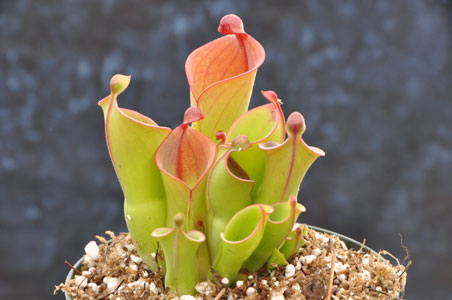Heliamphora Care
Get the straight facts from guys who grow and propagate thousands of carnivorous plants every year.

Heliamphora, commonly called Sun or Marsh Pitchers, are perhaps the most mystifying and elegant of all pitcher plants. In contrast to the flamboyant
Nepenthes or imposing Sarracenia, a full-grown Sun Pitcher represents more the suggestion of carnivory than a declaration. They help us imagine what the first pitcher plants may have looked like. Hailing from the remote tabletop mountains of northern South America, some Heliamphora barely seem to be more than rolled leaves, while others have developed the flamboyant colors like their northern relatives the Sarracenia. A mature Heliamphora is stunning and will often mesmerize those seeing it for the first time. Currently, more or less fifteen species have been identified, but the most common one found in cultivation is a naturally occurring hybrid,
Heliamphora heterodoxa x minor.
Heliamphora grow very slowly. A juvenile plant might not produce its first adult pitcher until it is 5 years old, and it might be another 5 years before it produces its first flower!
If you’ve successfully grown Nepenthes and other tropical carnivorous plants in the past, you will enjoy the challenge of keeping Heliamphora. If you’re new to growing carnivorous plants, gain some experience with other plants first. Read The Ultimate Carnivorous Plant Guide for Beginners to learn more about growing some of the easier and more common plants in cultivation.
Range
Heliamphora are native to the tepuis (tabletop mountains) of Venezuela, with a more limited distribution in northern Brazil and southern Guyana.
Where to Grow
Heliamphora prefer very stable growing conditions. They will acclimate to lower humidity if the temperatures are relatively stable throughout the day. Large fluctuations in both humidity and temperature will slow this plant down even further, and can even cause them to drop their leaves. However, many growers have had success growing Heliamphora in sunny, draft-free windowsills where temperatures remain between 60° and 80°F (16° and 27°C), both day and night. Otherwise, this is one of the few exceptions in which a well-ventilated terrarium may be a good option, to stabilize both temperature and humidity.
Sunlight
Heliamphora require a fair amount of sunlight, which can be a bit of a dilemma for the first-time grower. In most homes, increasing the sunlight also means increasing the ambient temperature, which will work against the plant (their wild habitat is tropical highland, where it is both bright and cool). If you are growing your plant in an open terrarium, you will need to use artificial lighting. Never give your plant direct sunlight while it's in a terrarium - this is like parking your car in the sun, and your plant will bake. Use 40-watt fluorescent tubes. You may also use compact fluorescent bulbs, but make sure they are equivalent to 100 watts or more. Keep the light source approximately 6-8 inches above the plant. The light should be on for 16 hours during spring and summer, and 12 hours during fall and winter. Avoid using incandescent bulbs. They produce too much heat and the wrong light spectra.

Water
Heliamphora do not do well sitting in water. Keep your plant in no more than 1/4-inch of water in its tray. This helps keep the soil moist at all times, and provides some humidity around the plant, while keeping the media aerated, free of standing water.
Another option is to simply water the plant several times weekly. Pour water over the pitchers and into the soil. It is all right if water gets in their pitchers, this happens naturally in the wild when it rains. Make sure the soil never dries out and establish a water routine. On hot days, it may be a good idea to water in the morning and in the evening, but it's preferable that Heliamphora don't experience temperatures above the mid-80s F (approximately 28° C.).
Regardless of your watering method, use mineral-free water whenever possible.
Soil
The soil needs to be both well-aerated and retentive of moisture. If possible, use live sphagnum moss. Otherwise, a simple mix of equal parts dry long-fiber sphagnum moss and perlite will work. This mixture provides excellent drainage and aeration. Avoid using potting soil, compost and fertilizer.
Need more information about growing Heliamphora? Watch our Volume 3 playlist. The last video in the playlist is about Heliamphora.
